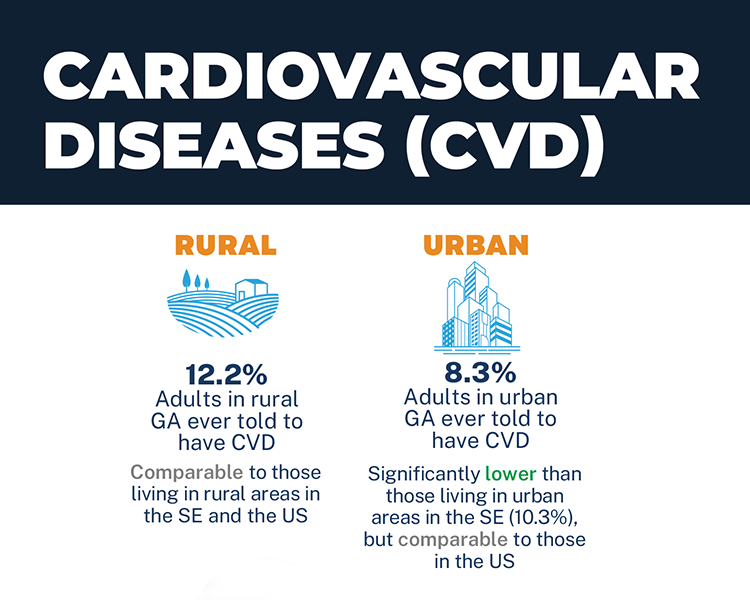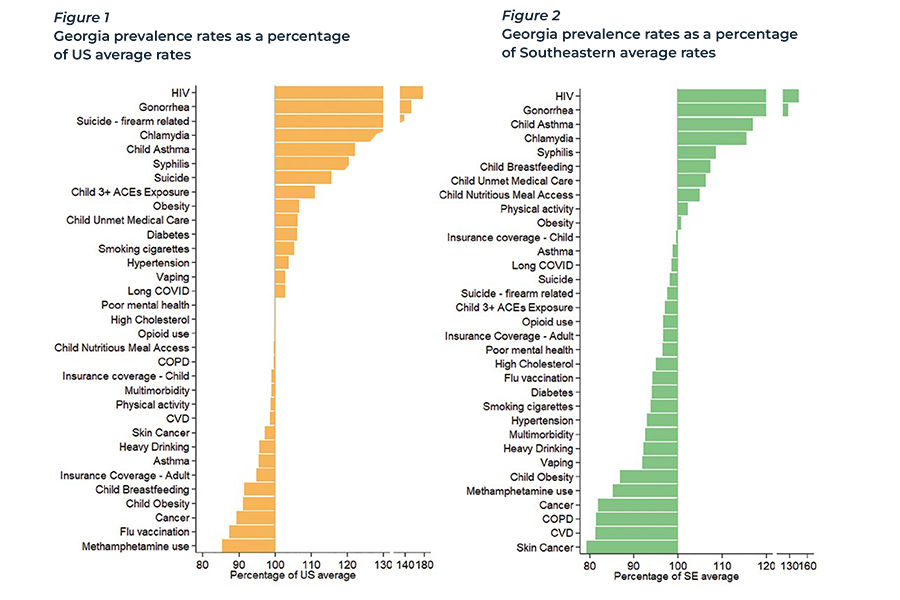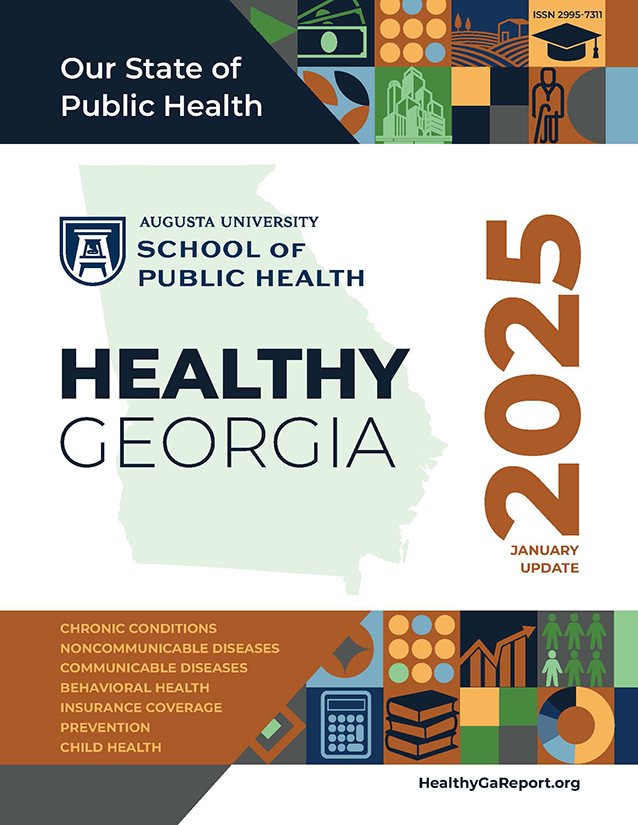The fourth edition of the “Healthy Georgia: Our State of Public Health” report has been released by the Institute of Public and Preventive Health in Augusta University’s School of Public Health.
Within the 64 pages of the report is a snapshot of how healthy Georgians are compared to citizens across the 12 states that make up the Southeastern Region (Alabama, Arkansas, Florida, Georgia, Kentucky, Louisiana, Mississippi, North Carolina, South Carolina, Tennessee, Virginia and West Virginia) and the entire United States. The 2025 edition addresses 31 health topics and has been expanded this year to include multimorbidity; long COVID-19; HIV, chlamydia, gonorrhea and syphilis infection rates; opioid and methamphetamine drug use; suicides; and vaping.
“As Georgia’s preeminent public health sciences and medical research university, Augusta University plays a vital role in discussions about the health of our state’s citizens,” said Augusta University President Russell T. Keen. “Although our School of Public Health is the newest in the state, our Institute of Public and Preventive Health has been making significant contributions for many years, and our Georgia Prevention Institute has done so for decades. Faculty researchers from across our university, including the School of Public Health, the Medical College of Georgia, the Dental College of Georgia, the Georgia Cancer Center, the Immunology Center of Georgia, as well as the College of Allied Health Sciences, the College of Nursing and the College of Education and Human Development, are dedicated to improving the health of all Georgians, and this report is a vital part of that process.”
The report, which is the only one of its kind in the state, has been delivered to lawmakers, community leaders and researchers across Georgia to provide them with tangible figures on how Georgia is faring in numerous areas.
“Each year, we strive to release a better, more comprehensive report than the year before, and this year is no exception,” said J. Aaron Johnson, PhD, director of IPPH and associate dean for Research and Community Engagement in SPH. “Dr. Datta and his team have worked hard to collect and analyze the most recent data and present it in a way that will stimulate conversations about public health needs in our state and, in turn, promote action, including policy changes, greater community engagement and the appraisal of funds that will help all Georgians live healthier lives.”
The mission of the School of Public Health is to address Georgia’s distinct public health challenges through exceptional education, innovative research and collaborative community engagement.
“The Healthy Georgia Report is an important tool for benchmarking the health of Georgians and highlighting opportunities for improvement,” said Teresa Waters, PhD, founding dean of SPH. “I am proud of the work that Dr. Datta and his team have put into this report, continuing to expand the topics covered so it can better serve our policymakers, health care professionals and the citizens of Georgia.”

Biplab Datta, PhD, assistant professor in the Department of Health Management, Economics, and Policy in SPH, heads up the team of IPPH faculty and staff who create the report each year. Datta credits Jen Jaremski, research associate, and Kit Wooten, public health analyst, with handling much of the work of bringing the report to life. Together, Jaremski and Wootten collected and organized all of the needed assets and organized the 64-page document, preparing it for print and the web.
“Every year we strive to present data in a way that policymakers may find helpful in making policy choices,” Datta said. “There are several new topics that were added to this year’s report and some of those are concerning for the state of Georgia, particularly the communicable diseases like HIV, chlamydia, gonorrhea and syphilis. High prevalence rates of these conditions in Georgia, compared to the rest of the U.S. and the Southeastern Region, warrant attention of the public health community.”
Georgia has the second-highest rate of HIV infections in the U.S., fourth-highest rates of gonorrhea, sixth-highest for chlamydia and 13th for syphilis.
Something that is also new in this year’s report is a comparison of numbers from 2019, or before the COVID-19 pandemic began, compared to after the pandemic for certain conditions.
Also coming out of the pandemic, the report looks at how long COVID has affected Georgians, with the state ranking 24th in the nation for rates of long COVID. According to the U.S. Centers for Disease Control and Prevention, long COVID is defined as a chronic condition that occurs after COVID-19 infection and is present for at least three months.
On top of looking at comparisons between Georgia and the Southeast and the nation, Datta noted a clearer picture is starting to emerge concerning the difference in urban and rural areas within the state.
“For several chronic conditions, like hypertension, diabetes and multimorbidity, we clearly see a striking difference between rural and urban residents of Georgia,” Datta said.

Hypertension affects 44.1% of adults in rural Georgia compared to 35% in urban areas, while diabetes affects 17.5% of adults in rural Georgia compared to 12.3% of those in urban areas. Hypertension and diabetes are major risk factors for cardiovascular disease, which affects 12.2% of adults in rural areas compared to 8.3% of adults in urban areas of Georgia.
“Hypertension and diabetes are the major risk factors for heart disease, which is the leading cause of death in the U.S. and worldwide, so these are some concerning numbers to see,” Datta said.
Multimorbidity, which is when a person has multiple chronic conditions, including obesity, asthma, chronic obstructive pulmonary disease, depression, kidney disease, diabetes, hypertension, high cholesterol, cardiovascular disease, cancer, skin cancer and arthritis, affects 57.4% of adults in rural Georgia compared to 49% of adults in urban areas of the state. These rates are significantly lower than the rest of the Southeast but on par with the rest of the country.
When comparing Georgia to the U.S. national average, adults in Georgia have lower rates of cancer and methamphetamine use but higher rates of childhood asthma and adult obesity. At the same time, rates of adult asthma and adult obesity among Georgians were comparable to the averages seen in the Southeast. Interestingly, while adult health insurance coverage was significantly lower than the U.S. national and Southeast Regional averages, the child health insurance coverage in Georgia was comparable to both national and regional averages.

 Augusta University
Augusta University





